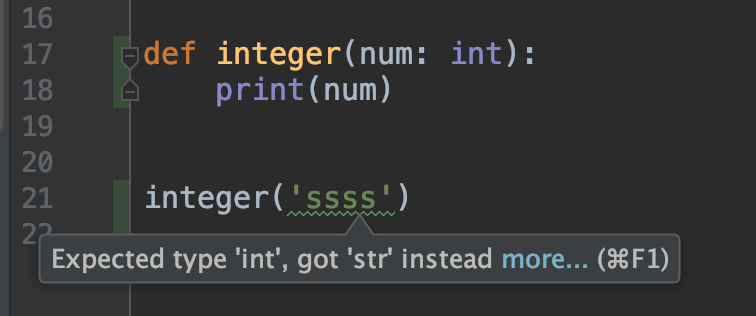赋值
常规赋值 =
序列解包
序列解包(或可迭代对象解包):将一个序列(或任何可迭代对象)解包,并将得到的值存储到一系列变量中
用途
- 同时给多个变量赋值
- 交换多个变量的值
a, b, c = 'x', 'y', 'z' ### a的值即为'x't = (1, 2, 3)c, d, e = t ### c的值即为 1
链式赋值
链式赋值是一种快捷方式,用于将多个变量关联到同一个值
x = y = somefunction()#上述代码与下面的代码等价:y = somefunction()x=y这两条语句可能与下面的语句不等价:(之所以说“可能”不等价,与 python 自身数据存储的设计有关系而分别指向不同的对象)x = somefunction()y = somefunction()
增强赋值
如 x = x + 1, 可以写成 x += 1.
>>> x = 2>>> x += 1>>> x *= 2>>> x ### 输出为 6
比较运算符、数据类型检查与同一性检查
python 的数据类型通常根据变量的值进行确定。 在交互器中我们也可以用内置的
type(obj)获取类型;程序中则可以使用isinstance()检查是否为某类的实例(但同时也破坏了其封装性) 另外在赋值后,如果需要检查两个对象是否相等,可以用双等号==/!=;如果需要检查两个变量是否为用一个对象,可以用is/is not
>>> a = []>>> type(a) ### 输出为 <class 'list'>>>> a = [1,2,3]>>> b = [1,2,3]>>> a == b ### 输出为 True>>> a is b ### 输出为 False>>> a = 257>>> b = 257>>> a is b ### 输出为 False>>> a == b ### 输出为 True>>> a = 256; b = 256>>> a is b ### 输出为 True>>> a is not b ### 输出为 True>>> a = 10; b = 5; a > bdef zero(num):if isinstance(num, int):if num == 0:raise EOFError("内容为空")else:print(num)return Falseelse:raise ValueError("非数值类型")
条件
布尔值
标准值False和None、各种类型(包括浮点数、复数等)的数值0、空序列(如空 字符串、空元组和空列表)以及空映射(如空字典)都被视为假(False),而其他各种值都被视为真(True)
布尔运算的短路逻辑
假设表达式x and y才为真。因此如果x为假,这个表达式将立即返回假,而不关心y. 同理如 x or y
if 语句与 else 子句、elif 子句
# 示例 1def test(a: list): ### 引用了3.6的特性,是期望接收list,但非法输入不会引起报错if a: ### 这个写法是PEP8风格,表示条件a为真。等价于 if a is True:print('get one list')else:print('oops!')print('cool') ### 不论条件判定是什么,都会执行。Python的代码块创建是根据缩进来的test([1, 2])test([])# 示例 2def judgement():try:age = int(input("what's your age: "))if 100 > age >= 18:print('已成年')elif 0 < age < 18:print('未成年')else:raise ValueError('输入不合法')except TypeError:raise ValueError('输入数字')
断言 assert
>>> age = 10>>> assert 0 < age < 100>>> age = -1>>> assert 0 < age < 100, "age在0-100间"Traceback (most recent call last):File "<stdin>", line 1, in <module>AssertionError: age在0-100间
循环
while与for
while 可用在如轮询的实现中 不同于其他语言如 Java 的 for 循环,Python中属于 foreach 的设计,语法上通常是 for … in…
def while_case():lst = [None]print('The initial length is: ' + str(len(lst)))while 1 <= len(lst) < 10:lst.append(len(lst) + 1)print('Now the length is: ' + str(len(lst)))def while_case_2(statement):while statement is not None:print('content is %s' % statement)return statementdef foreach_1():word = 'string'for i in word:print(i)def foreach_2():for i in range(10):print(i)def foreach_3():word = 'string'for i in range(len(word)):print(word[i])def foreach_4():mapping = {'k1': 'v1', 'k2': 'v2'}for k, v in mapping.items():print(k, v)
跳出循环 break, continue, return
break无需再迭代,直接跳出最近的循环continue结束当前迭代,并跳转到下次的迭代开头。意味着跳过循环体中余下的语句,但不结束循环return结束函数。意味着 return 之后的语句都不再执行
示例
轮询实现示例
#!/usr/local/bin/py3# -*- coding:utf-8 -*-"""@Interpreter: Python3.9@File: polling@Description:@Author: hailong.chen@Date: 2022/1/18 14:24@ModifiedBy:"""from datetime import datetime, timedeltadef polling(timeout=3):"""timeout 时间内执行动作"""start = datetime.now()end = start + timedelta(seconds=+timeout)while 1:print("执行动作.....")current = datetime.now()print(current)if current >= end:print("动作执行...{timeout}s 超时结束".format(timeout=timeout))breakprint('结束轮询')returndef polling_optimizely(timeout=3):"""timeout (秒)时间内,每间隔0.5s执行一次动作"""start = datetime.now()current = datetime.now()_interval = 0.5end = start + timedelta(seconds=+timeout)while 1:print("%s 时间,执行动作....." % current)if current < end:current += timedelta(seconds=_interval)else:print("动作执行...{timeout}s 超时结束".format(timeout=timeout))breakprint('结束轮询')returnpolling()polling_optimizely()
获取两个列表的交集示例
a = [1,2,3]b = [2,3,5]for i in a:if i in b:print(i)# 输出结果: 2,3
排序算法示例
冒泡排序示例
通常对于排序,可以直接用 sort(), sorted(), reverse() 等
def do_sort():# 冒泡排序要排序n个数,由于每遍历一趟只排好一个数字,# 则需要遍历n-1趟,所以最外层循环是要循环n-1次,而# 每趟遍历中需要比较每归位的数字,则要在n-1次比较中# 减去已排好的第i位数字,即每趟循环要遍历是n-1-i次lst = [1, 4, 3, 5, 2]for i in range(len(lst)-1):for j in range(len(lst)-1-i):if lst[j] < lst[j+1]:lst[j], lst[j+1] = lst[j+1], lst[j] # 这里使用的是序列解包进行值互换print(lst)do_sort()



